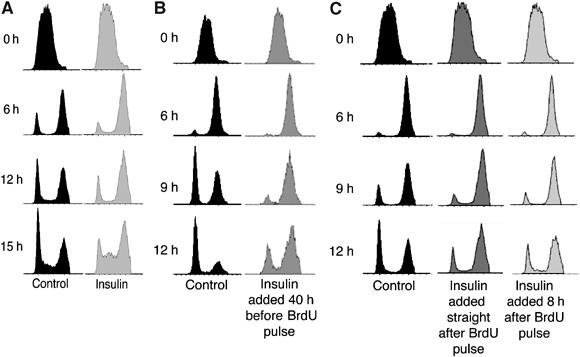Figure 2.

Insulin slows progression from S phase through G2/M. (A) S2 cells seeded at 1 × 106 cells/ml were pulse-labelled with BrdU for 15 min, grown in the presence or absence of 1 μM insulin and the cell-cycle profiles of BrdU-labelled cells were recorded by flow cytometry. The BrdU-labelled insulin-treated cells pass more slowly from S phase through G2 and M phases (6 and 12 h time points) and more quickly from G1 into S phase (15 h time point). Results shown are representative of four independent experiments. (B) S2 cells seeded at 1 × 106 cells/ml were grown in 1 μM insulin for 40 h before labelling with a pulse of BrdU for 15 min. Passage of the BrdU-labelled cells was followed for a further 12 h. The ability of insulin to delay progression through G2/M was apparent after 6, 9 and 12 h. (C) S2 cells seeded at 1 × 106 cells/ml were labelled with a pulse of BrdU for 15 min and then 1 μM insulin was added immediately or after 8 h. Passage of the BrdU-labelled cells was followed for 12 h. Even 9 h after BrdU labelling, treatment with insulin for 1 h delayed progression of cells from S phase through G2/M. Results in (B) and (C) are representative of two independent experiments.
